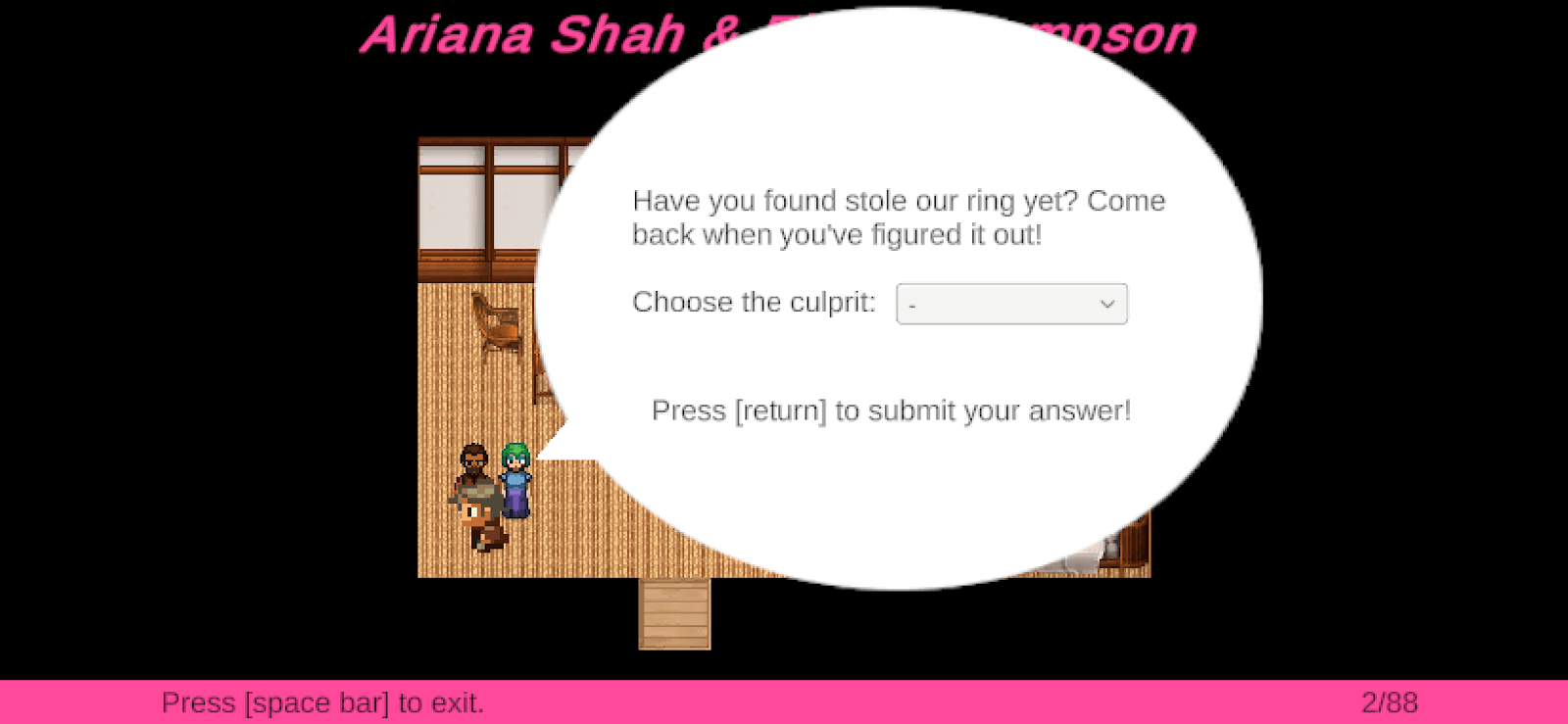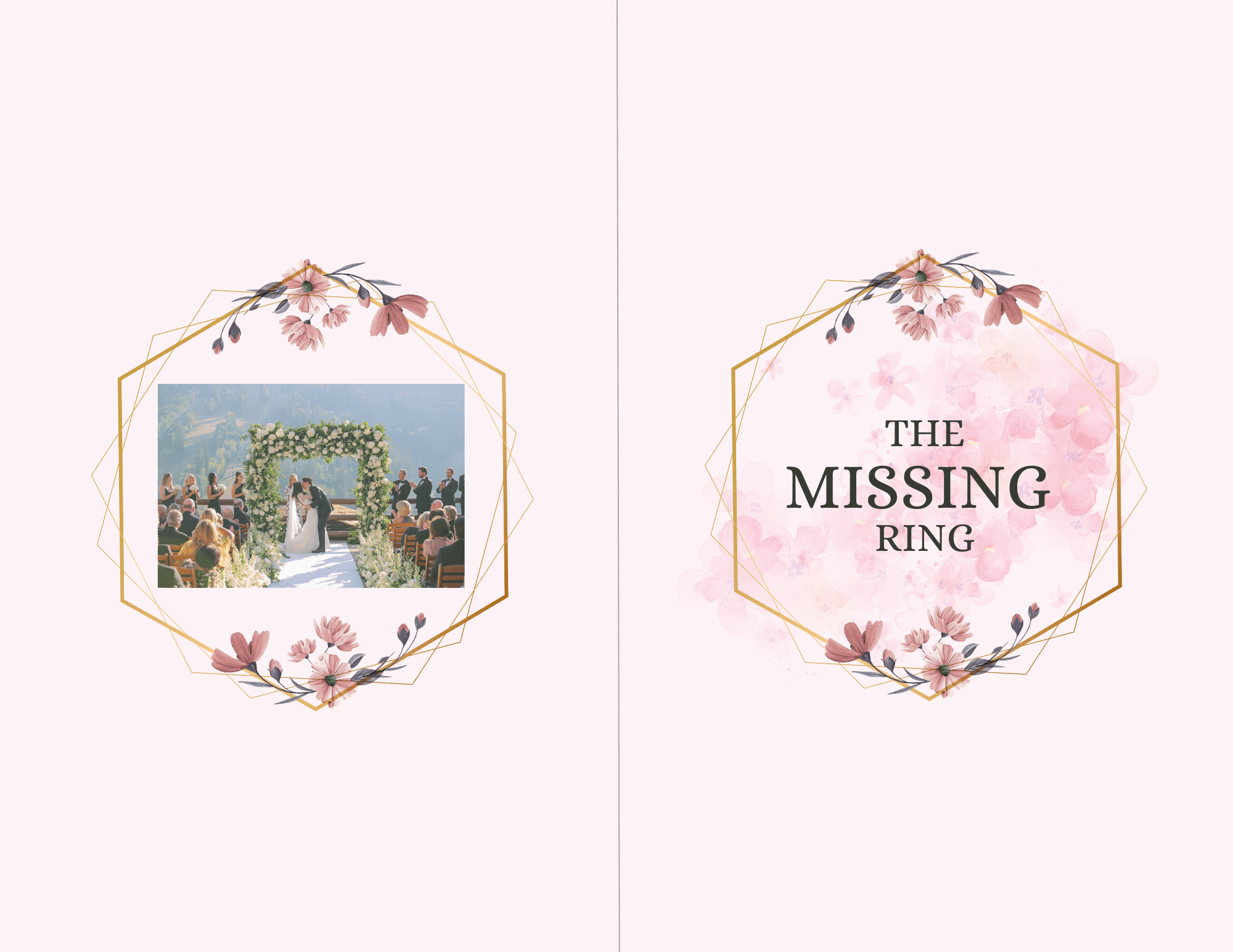The Missing Ring
Builds: https://drive.google.com/drive/folders/1zyJtEgjXOrs2VxDw_i4sJBGDP94rYlrQ?usp=sharing
Game Walkthrough: https://youtu.be/c4zzk4s4GN0
Scope: MVP
Architecture: Narrative Architecture & Spatial Architecture
Artist Statement
Our intention for this game is to immerse players in a rich, narrative-driven mystery where they must piece together clues scattered across multiple rooms to uncover the truth behind a wedding scandal. We aim to create an engaging experience that combines the thrill of exploration with the satisfaction of solving intricate puzzles. By incorporating diverse evidence types such as emails, documents, and visual clues, we strive to provide a dynamic storytelling environment that keeps players invested in the narrative. The game is designed to challenge players’ deductive reasoning while allowing them to sympathize with and understand the characters’ motivations. Through careful level design and narrative architecture, we hope to evoke emotions of suspense, curiosity, and excitement, making each discovery a rewarding part of the overall experience.
Target Audience
This game is for people who enjoy putting clues together and solving a mystery. Our audience should be motivated to uncover the story behind each of our suspects, and we are focused mainly on generating a compelling and complex storyline. Although we imagine that our audience will mainly be young adults, we intend on appealing to all ages.
Model: Concept Map
The game operates on a walking simulator adventure framework, where players navigate through different rooms, interact with objects, and gather clues. Each room is designed with a specific character in mind, containing 2-5 clues relevant to the narrative. Clues are highlighted with visual markers to guide players and maintain engagement.
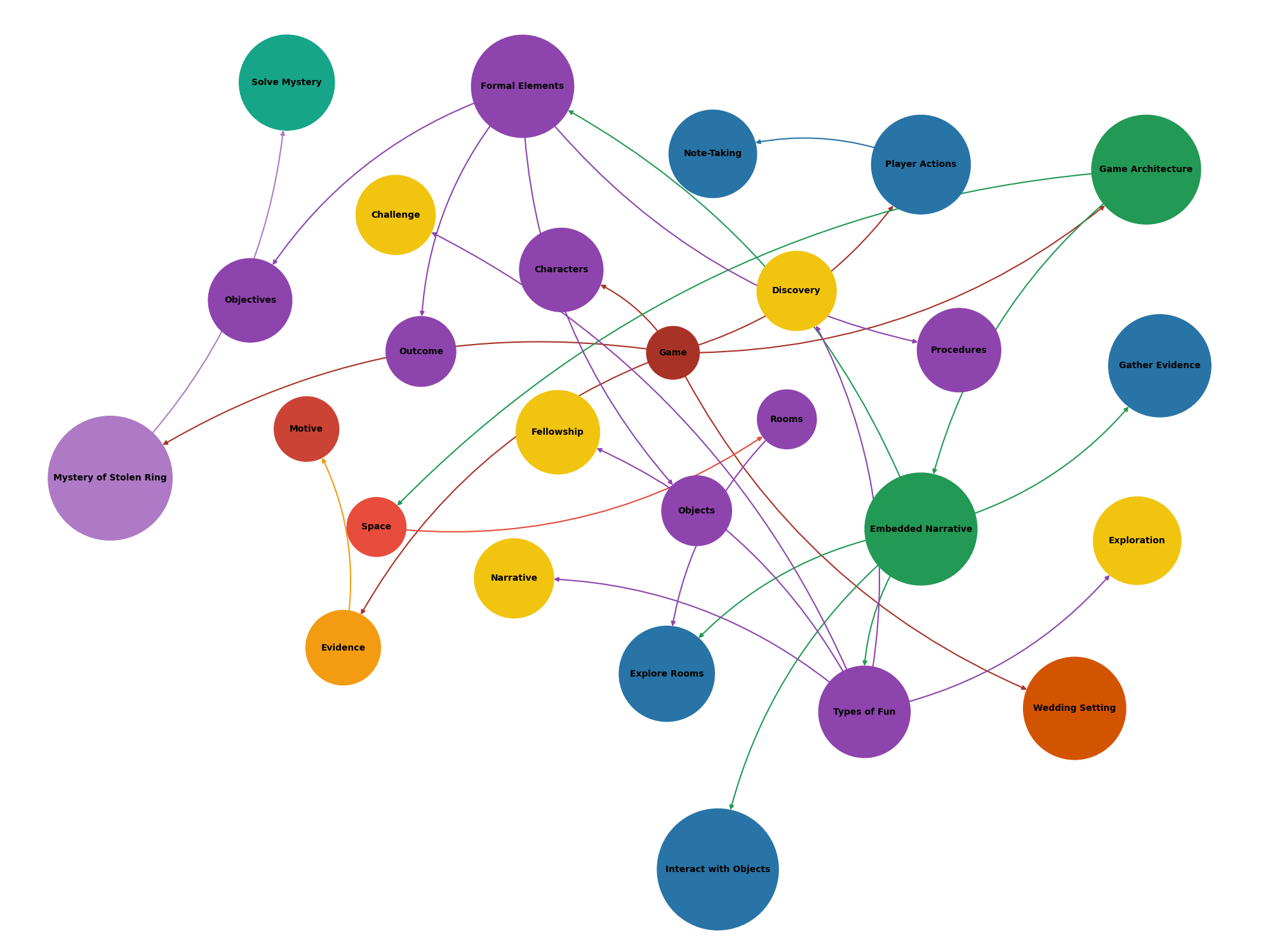
Concept Map Notes:
- Each room is connected to a central hub, allowing for non-linear exploration.
- Clues are scattered across rooms, requiring players to piece together information from multiple sources.
Initial Decisions about Formal Elements and Values
Formal Elements:
- Objects:
- Rooms: Each room is connected to a central hub, allowing for non-linear exploration. Rooms are designed to reflect the personality and background of the character associated with them.
- Clues: Clues are scattered across rooms, requiring players to piece together information from multiple sources. Types of clues include visual markers, text-based evidence (e.g., emails, diary entries), and interactive objects.
- Player Actions: Players can interact with objects to gather evidence, take notes, and make deductions. Interactions include examining objects closely, zooming in on details, and taking notes.
- Objectives:
- The main objective is to solve the mystery of the stolen ring by piecing together clues and uncovering the motives of different characters. Players must explore rooms, gather evidence, and use their deductive reasoning to identify the culprit.
- Procedures:
- Players start in a central hub and choose which rooms to explore first.
- In each room, players can interact with various objects to uncover clues.
- Players take notes and use the information they gather to form hypotheses about the culprit.
- The game provides a notebook feature to help players keep track of their findings and thoughts.
- Outcome:
- The game concludes when players are confident they have identified the culprit and present their findings. A correct identification of the thief results in a satisfying resolution of the mystery, while an incorrect guess leads to further investigation.
Values:
- Narrative Immersion:
- The game aims to deeply immerse players in a rich narrative experience. Through detailed character backstories and meticulously designed rooms, players feel like they are part of the wedding environment and its unfolding drama.
- Exploration and Discovery:
- Encouraging thorough exploration and discovery is a core value of the game. Players are rewarded for their curiosity and attention to detail as they uncover hidden clues and piece together the story.
- Challenge and Engagement:
- The game is designed to challenge players’ deductive reasoning and problem-solving skills. By providing a variety of evidence types and complex character motivations, the game keeps players engaged and invested in solving the mystery.
- Player Agency:
- Ensuring players feel a sense of agency and ownership over their investigative process is crucial. By allowing non-linear exploration and multiple ways to piece together clues, players can approach the mystery in their unique way.
- Cohesion and Clarity:
- Maintaining a cohesive and clear narrative is essential. Even with multiple characters and a plethora of clues, the story should make sense and provide a logical progression for players to follow.
These initial decisions about formal elements and values guided the development process, ensuring that every aspect of the game—from the design of the rooms to the types of clues provided—worked together to create an engaging and immersive mystery-solving experience.
Documentation of Testing/Iteration History
Playtest 1: Setting, Game Scope, Characters
Date: May 7, 2024
Participants: 4 classmates in class
Playtest Questions:
- Does our setting feel appropriate?
- We created a fictional island and designed a map to show playtesters.
- What should be the scope of our game? What types of fun are we trying to incorporate?
- The idea for our game began as a heist, where all players were invited to this wedding on a mission to steal the ring. However, upon arriving at the island, someone has already stolen the ring. Therefore, our game was (1) a who-dun-it to find the person who stole the ring and (2) a physical heist where players steal the ring from the first thief.
- What are potential characters to include? What characters/roles do players act as v.s. which characters/roles are built into the game?
- As players attend this wedding to steal the ring, how did they get invited? Who had the motive to steal the ring before the players even got a chance?
Key Takeaways:
- Setting: Our playtesters liked looking around the island and everything it included. Questioned which characters would be living in the family estate vs at an external hotel. Would any of the players be close enough to the family to actually stay there?
Initial sketch of our island
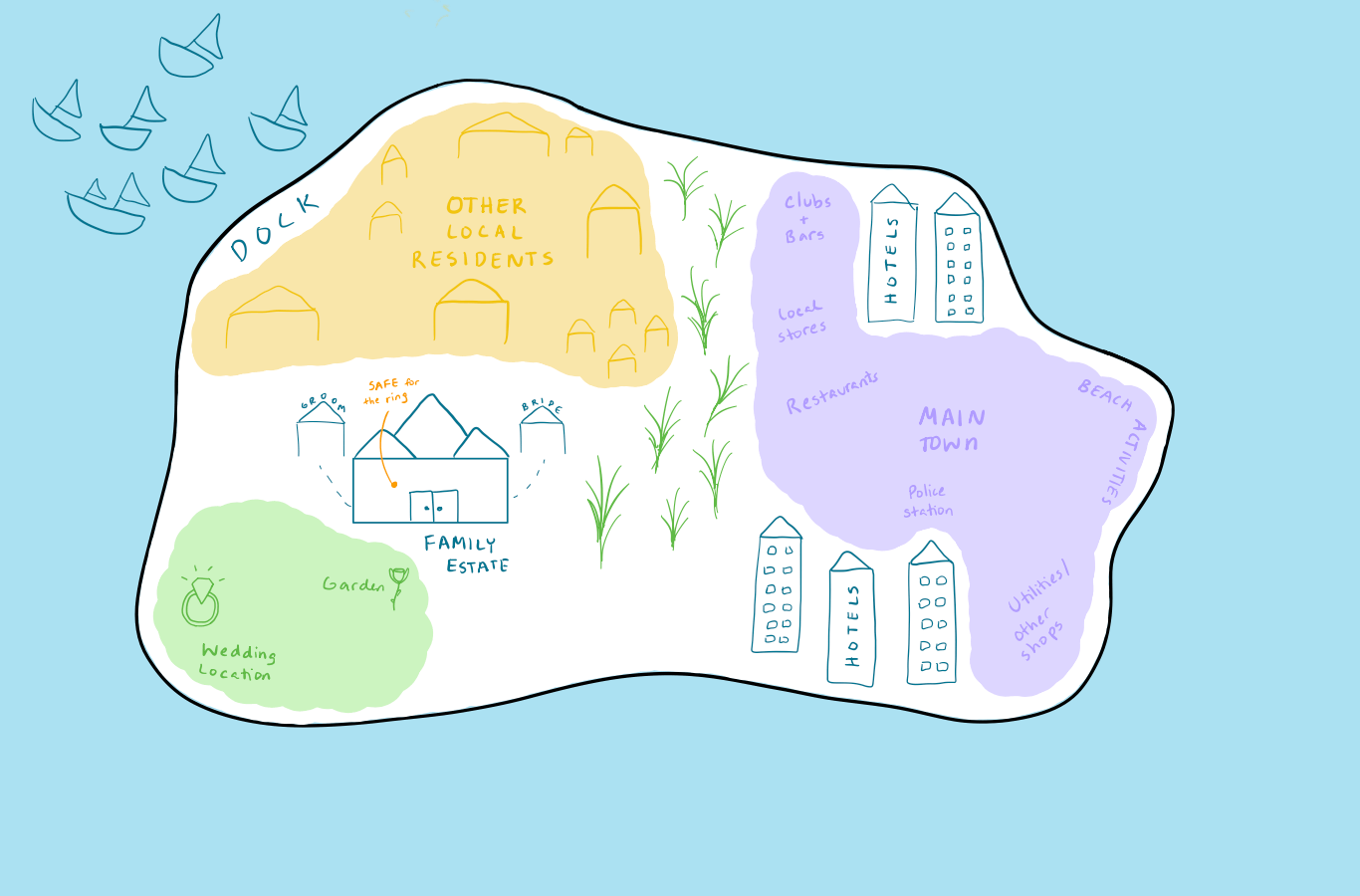
- Space: We spent a lot of time this week understanding what spaces our game would be most effective in. We found a physical space (in a room/dorm around campus) would be best at creating fellowship as players physically work together to steal a ring from a room. However, all of us agreed the “who-dun-it” part involved exploring the entire island which would not be easy to recreate in a physical setting. Therefore, we debated making our island exploreable in minecraft or a different 2D/3D platform.
- Scope: The above discussion about space also led us to reconsider the scope of our project. We did not have enough time to create a multi-modal game, which is when we decided to only build the “who-dun-it” part of our initial concept. Additionally, when ideating about our game’s formal elements, we realized that the heist and mystery were almost two separate games. They both had different outcomes, objectives, and procedures to reach there.
- Replayability: Upon hearing our idea, our playtests wondered whether our game would be replayable. We considered multiple options for how our game could be replayable, but decided that we wanted challenge as a main type of fun. Therefore, we wanted to create a really intricate narrative and specific evidence that players would have to spend more time grappling with.
- Characters: Our concept doc outlined our eight characters and their respective motives for initially stealing the ring. Playtesters mentioned that they would prefer each character to have different motives. For example, our concept doc showed the friend/wedding planner and the sibling to both be motivated partially through financial struggles.
Initial Brainstorming of Different Character Narratives
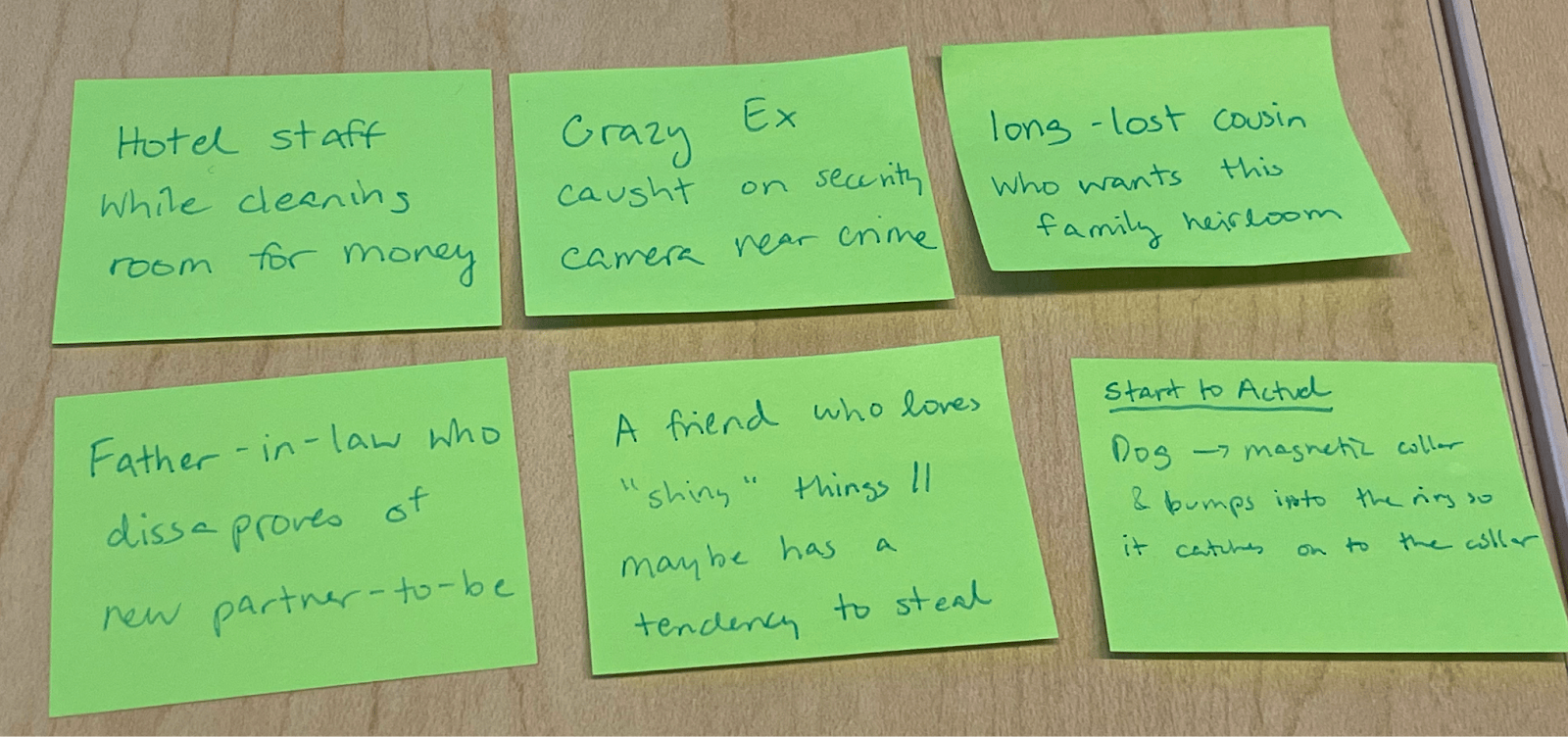
What Went Well:
- Fascinated by the theme, drawing comparisons to the “Knives Out: Glass Onion” movie!
- Excited by the prospect of players being able to work together to solve the mystery.
What Didn’t Go Well:
- Confused about the premise. Once revealing the idea of players working together to steal this precious item, they were unsure if they were working with the person who stole the ring, or were supposed to steal the ring themselves.
- Questioned how the game could be replayable, if that was something we were designing for.
Iteration/Next Steps:
- We established that players would stumble on the island and must figure out who stole the ring rather than trying to steal it themselves. So the game genre switched from a heist to more of a whodunit.
- We established a few characters based on different archetypes that tend to present themselves in these situations, whether from movies or books. For instance, we wanted to create a sort of “enemy to the father character” who is immediately suspicious , since it’s not immediately clear why he would want to attend the wedding of the daughter of the man he hates. Additionally we created other characters such as the grandmother who doesn’t approve of the bride, the jealous sibling, the heartbroken ex, the one relative in massive debt, the child who likes to take shiny items. We also wanted to throw a fun one in there so even include a dog as a potential suspect as he may have swallowed the ring.
- To establish these characters and motives we created evidence that felt what would be most natural for characters to share their internal thoughts. This included diary entries for nearly every character which was an outlet to express their thoughts and feelings. We also noticed email and text messages felt effective in establishing relationships with other characters (i.e. email to cousin that he owes people money). And for Roshan since he worked for a company, creating business documents felt appropriate to be found on his computer.
Playtest 2: Half Narrative
Date: May 14, 2024
Participants: 3-4 classmates in class
Playtest Questions:
- Can players determine the basic motive for the first four characters we created rooms and evidence for? (Brother Ben, Ex Ben, Ashley Wedding Planner, Best friend with dog)
- Is the evidence engaging? Are playtesters having fun discovering the embedded narrative? Is it the right level of challenge?
Key Takeaways:
- Narrative Engagement:
- Discovering the narrative through evidence was fun and immersive. Some characters, like “Drunk Ben” (a name given by playtesters to distinguish “drunk Ben” and “sad Ben”), were easier to sympathize with. Players found it complicated to keep track of characters as more narratives were introduced. Suggested including an introduction for the game to convey the setting and wedding background.
- Evidence and Clues: Scattering evidence across rooms encouraged exploration. Our game architecture became an embedded narrative that players were trying to uncover. Playtesters loved some of the non-relevant evidence cards. They said it enhanced the realism! Different types of evidence (emails, documents, visuals) kept the game dynamic.
For Playtest 2, “Drunk Ben’s” nightstand drawer was simply empty!

- Embedded Narrative: We transitioned from a heist theme to an embedded narrative game architecture, focusing on discovering clues to unravel the story. This shift allowed us to deeply integrate storytelling within the game world, making every piece of evidence a critical component of the overarching mystery. By embedding the narrative in the environment, players became active participants in uncovering the story rather than merely following a linear plot. This approach emphasized player exploration and interpretation, creating a richer and more immersive experience.
- Gameplay Mechanics: Without our prompting, playtesters individually asked if they could take notes on their iPad as they went through the game to keep track of the narratives. This indicated that players wanted a way to jot down thoughts as they played our mystery game. This insight led us to consider incorporating an in-game note-taking feature or providing physical notebooks to enhance player engagement and aid in their investigation. Additionally, this playtest made us realize the importance of potentially structuring the game to guide players through the narrative in a specific order. We began contemplating whether to implement a linear exploration path or allow free exploration, balancing the need for narrative coherence with player freedom.
Playtester’s iPad Notes
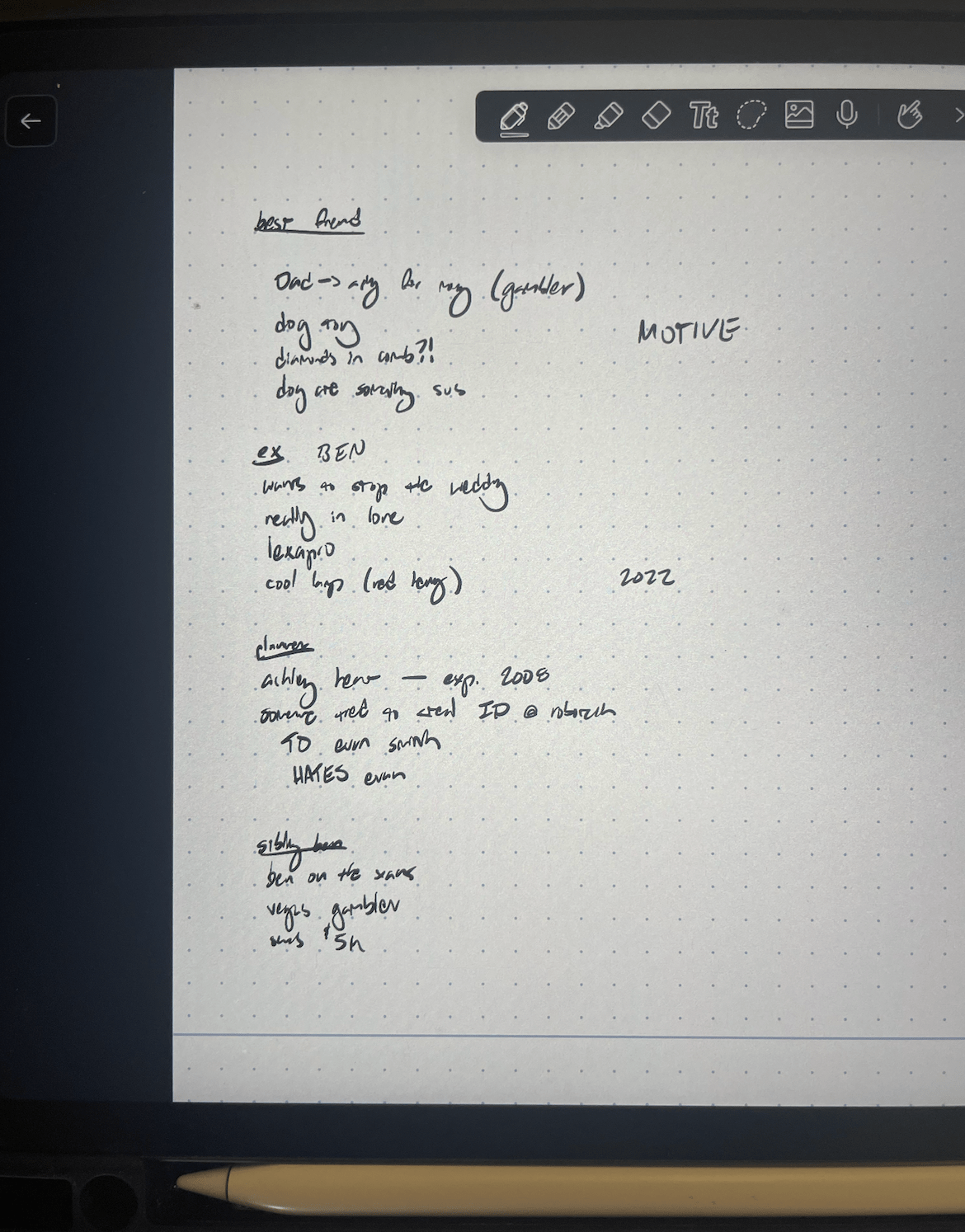
- Space Utilization: We designed spaces that required players to move throughout different rooms to gather evidence, emphasizing the importance of space in the game architecture. This design choice encouraged players to physically interact with the game world, making the act of exploration a central gameplay element. Each of us created a room layout sketch (some were aerial views, others were more first-person). This was our first attempt at exploring how space is used in our game. These sketches helped us visualize how players would navigate the environment and identify potential chokepoints or areas of interest. Our exploration of space utilization also highlighted the need for distinct visual and thematic differences between rooms to maintain player interest and support the embedded narrative. This could involve varying the decor, lighting, and types of evidence found in each room to reflect the unique characteristics of the characters associated with those spaces.
Sketches of our first four rooms
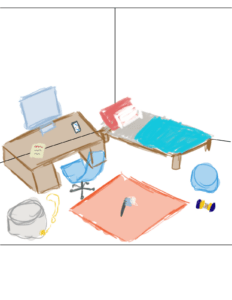

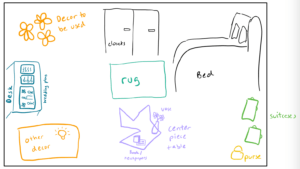
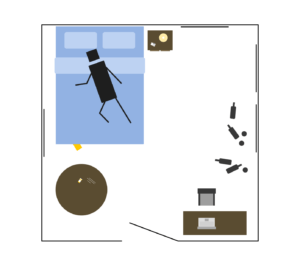
What Went Well:
- Players were highly engaged while discovering the narrative through evidence. A playtester remarking, “I was locked in!”
- The discussion amongst multiple players made the game incredibly exciting. The fellowship helped all players accurately determine the embedded narrative together and challenge each other’s ideas as they tried to uncover the truth. When one playtester had a misunderstanding, it was corrected through group discussion.
- Players were zooming in/out of evidence pieces to learn more. We realized we should implement this mechanic in our digital game.
Zooming into the dog toys to see whether there were any “Rings” hidden inside
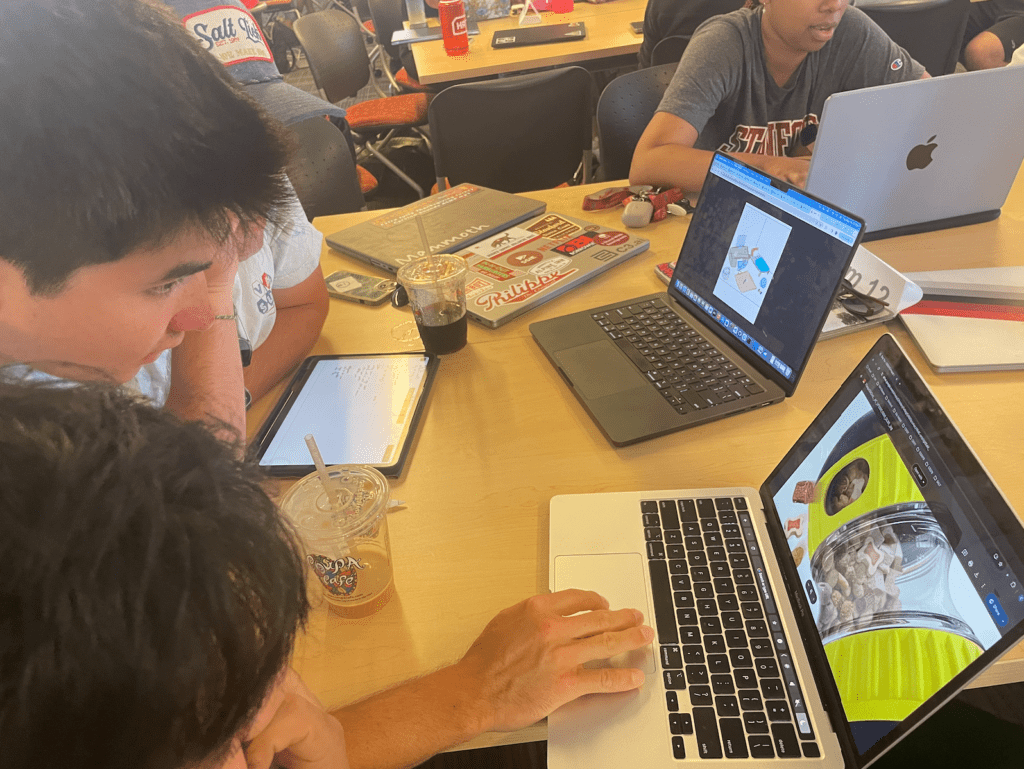
- Evidence in Drunk Ben’s room (Ben Thompson) was more holistic, so the playtesters mentioned that they were able to sympathize with him more because of that.
- Diversity of evidence types (emails, documents, photos, newspaper articles) were appreciated and kept the game dynamic.
What Didn’t Go Well:
- Players struggled to understand the best friend’s character (Dani Chue) but learned a lot about Ashley and the brother since there was more evidence in those rooms to find their narratives.
- Our game mechanics didn’t include a note-taking feature, which was needed when playing.
- There was no method to convey an introduction of the setting, wedding background, rules to play, or game’s objectives. Playtesters suggested including an introduction!
- Playtesters didn’t know once they found all the clues in each room. They kept exploring the best friend’s room even after they had already found all the evidence pieces. At the same time, playtesters quickly eliminated Sad Ben (Ben Anderson), so they left the room without exploring all of the evidence.
Iteration/Next Steps:
- Establish Names & Note-Taking Feature: Ritika to finalize all character’s names. Create a mechanic to convey this information to playtesters and develop a note-taking feature.
- Finalize Character Narratives: Kendal to create remaining rooms, clues, and narratives for the next four characters.
- Create Introduction: Zoe to develop the introductory scene and text.
- Evaluate Clues and Narrative: Casey to evaluate existing clues and narrative, and write up documentation.
Playtest 3: Full Narrative
Date: May 16, 2024
Participants: 1 classmate in class
Playtest Questions:
- Does our full narrative work? Do players get the right answer?
- What types of clues are the most engaging?
- How do players interact with note-taking and suspect lists?
- Does our description provide enough context for the game?
- Did players uncover/notice the alibis (i.e., were times and dates important)?
Key Takeaways:
- Narrative Engagement: Players enjoyed the narrative and the process of discovering clues. The narrative was engaging, and the discovery through evidence was fun.
- Evidence and Clues: Scattering clues across rooms was effective in encouraging exploration. The diversity of evidence types (emails, documents, visual clues) kept players engaged and interested. Emails were the most engaging, revealing emotional states and interactions.
- Context and Description: The context provided was generally good, although players were sometimes unsure about character relationships.
- Note-Taking: The note-taking feature was well-received and helped players organize their thoughts. Players liked taking notes to keep track of clues and narratives.
- Room Exploration: Players sympathized with certain characters, adding depth to the narrative. However, players often focused on more obvious clues, such as laptops and diaries, overlooking hidden ones. Some rooms, like Jessica’s, were explored in more depth, while others, like Evan’s, were glossed over.
- Alibis and Timing: Time and dates were not heavily focused on by players, indicating a need for more emphasis or clearer presentation.
- Character Depth: The best friend’s character still needed more narrative depth. Some characters’ motivations were unclear, leading to confusion.
What Went Well:
- Players were highly engaged while discovering the narrative through evidence.
- The note-taking feature was effective and well-received.
- Scattering clues across rooms ensured players moved around and pieced the narrative together.
- The diversity of evidence types kept players interested and engaged.
- Players sympathized with certain characters, adding depth to the narrative.
- Emails were particularly engaging, revealing emotional states and interactions.
- The context provided was generally good.
Player using the notetaking feature to keep track of the characters.
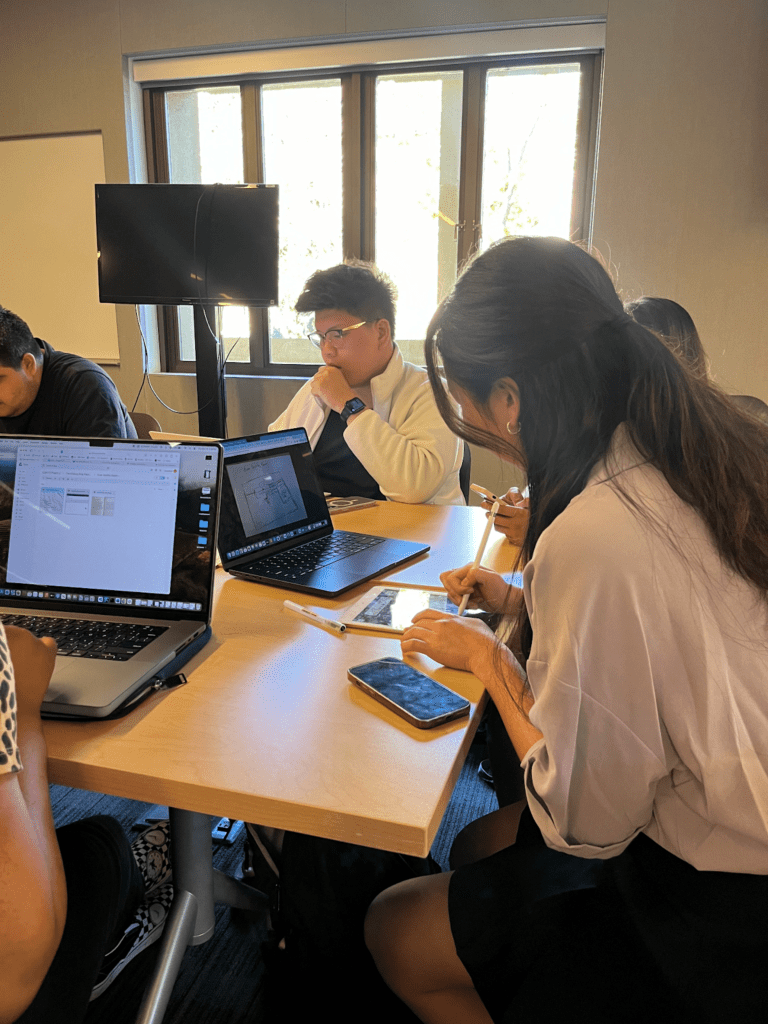
What Didn’t Go Well:
- Players often focused on more obvious clues, overlooking hidden ones.
- Some rooms were explored more thoroughly than others.
- Time and dates were not heavily focused on by players.
- The best friend’s character needed more narrative depth.
- Some characters’ motivations were unclear, causing confusion.
Iteration/Next Steps:
- Enhanced Character Backstories: Enhance character backstories and motivations to provide clearer context.
- In-Game Note-Taking: Implement an in-game note-taking feature to help players track clues and deductions.
- Introduction Scene: Add an introduction scene to set the wedding context and background.
- Balance Clues: Balance the number of red herrings and relevant clues to maintain challenge without causing confusion.
- Character Connections: Provide clearer connections between characters to help players understand relationships and motivations.
- Emphasize Timestamps: Add more evidence that contains timestamps to highlight the importance of time and dates (e.g., a voicemail indicating the time when the ring went missing).
Playtest 4: Full Narrative
Date: May 21, 2024
Participants: 2 classmates in class
Playtest Questions:
- What are the opinions of all the characters? Were their potential motivations clear?
- Were players focusing on all pieces of evidence, or just texts and emails?
- How important are time and dates in making deductions?
- Was it enjoyable playing with a partner, or would playtesters have preferred to play solo?
Key Takeaways:
- Character Opinions and Motivations: Playtesters felt like it was clear what all player motivations were and enjoyed the diversity in those motivations.
- Evidence Focus: Players initially focused on texts and emails but began to craft a timeline after noticing some evidence had timestamps.
- Partner Play: Playtesters had a great time playing and enjoyed having someone to play with to bounce ideas off of.
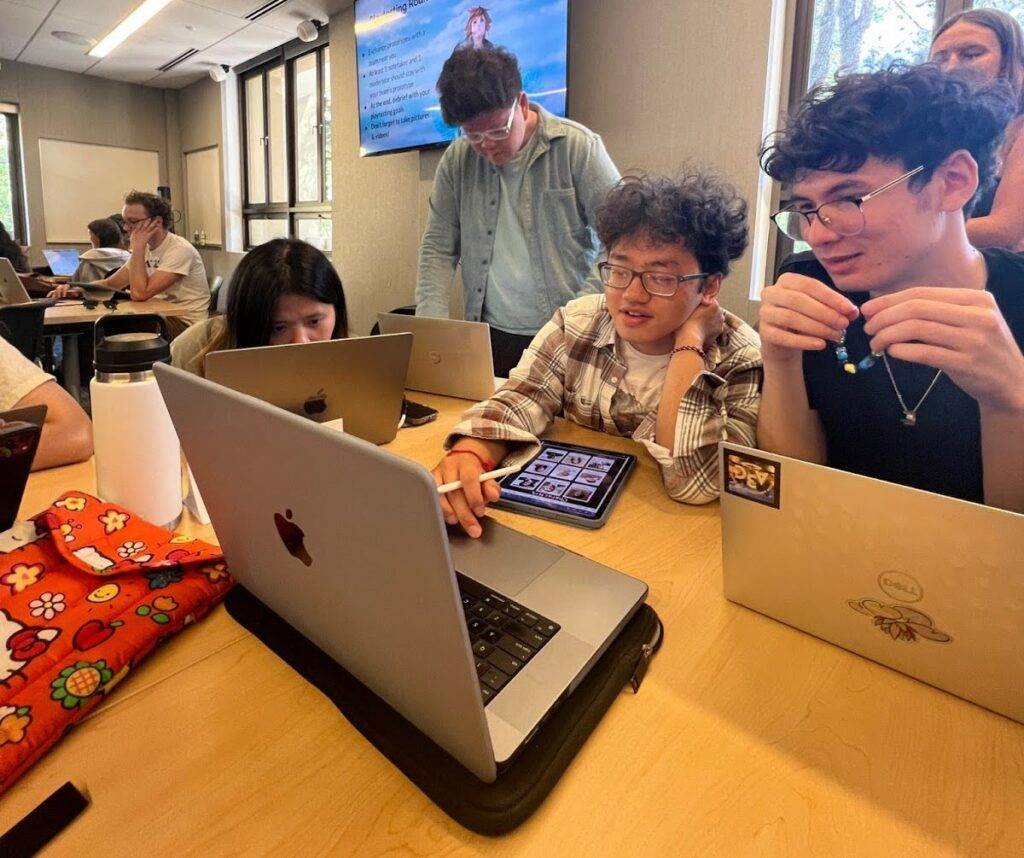
What Went Well:
- Playtesters enjoyed the narrative and the process of discovering clues.
- They appreciated the diversity in character motivations and found them clear.
- The social aspect of playing with a partner was well-received, enhancing the gameplay experience.
What Didn’t Go Well:
- Players noticed that some evidence didn’t match the overall timeline, leading them to disregard it completely.
- They wished they had a family chart to see how everyone was related.
- The evidence felt repetitive, with multiple rooms having both a diary entry and an email conveying the same information.
- Playtesters were confused about Evan’s motives, leading them to eliminate him as a suspect.
Iteration/Next Steps:
- Timeline Accuracy: Fine-tuning the timeline to ensure dates and times are accurate and align with the narrative, helping players eliminate suspects who have alibis. We made sure alibis made sense for the characters (e.g., grandma had a nurse who logs time, Dani had a dog grooming appointment).
- Suspicion Towards Evan: Adding a key and lockbox to draw more suspicion toward Evan, making it harder for players to ignore those clues.
- Family Relations: Adding a room layout to Ashley’s room that lists everyone’s relation to the bride and groom. Players must find this clue, ensuring they still need to dig and draw their own conclusions about the connections between characters until they find the specific clue.
Playtest 5: Full Narrative
Date: May 23, 2024
Participants: 1 classmate from class
Playtest Questions:
- Did playtesters find the room layout listing each character’s connection to the bride and groom helpful?
- How important are time and dates in making deductions?
- What are the opinions of all the characters? Were their potential motivations clear?
- Were players focusing on all pieces of evidence, or just texts and emails?
- Was it enjoyable playing with a partner, or would playtesters have preferred to play solo?
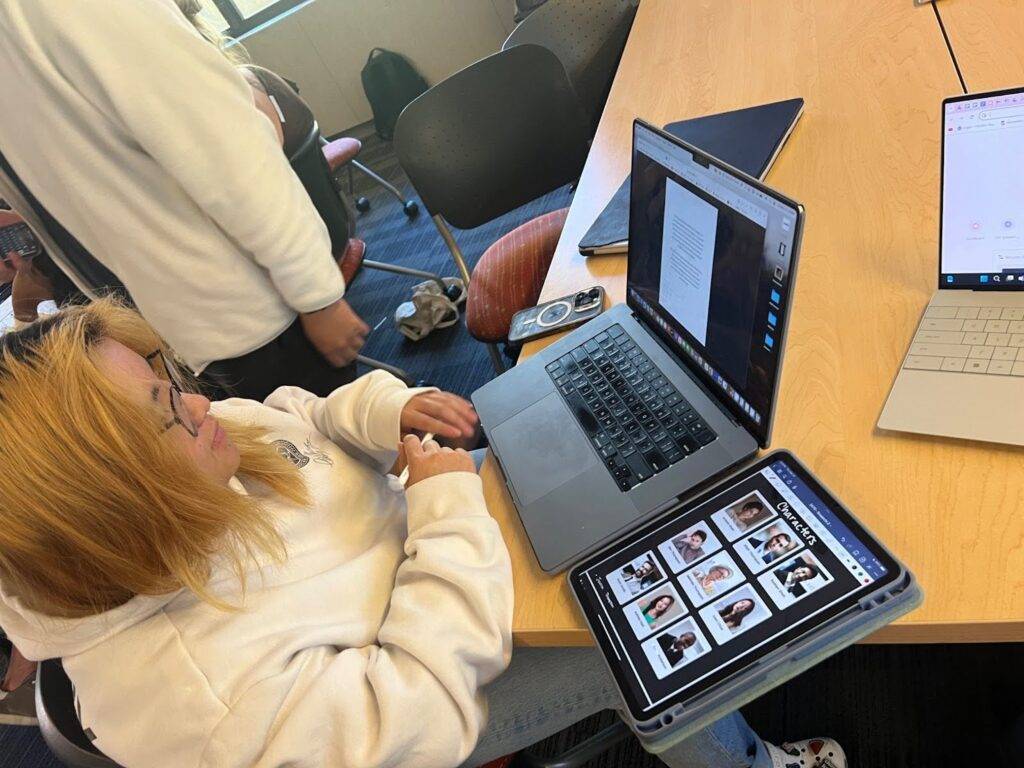
Key Takeaways:
- Room Layout and Character Connections: Playtesters appreciated the room layout as it helped clarify character relationships, especially after initial confusion about character identities (e.g., mistaking the father for the groom).
- Time and Dates: Time and date stamps were largely ignored by players, indicating a need for more emphasis or clearer presentation.
- Character Opinions and Motivations: Playtesters felt it was clear what all player motivations were and enjoyed the diversity in those motivations. There was some confusion about the relationships between the Thompsons and Ariana and Roshan, leading to misunderstandings about who was getting married.
- Evidence Focus: Players initially focused on texts and emails but began to craft a timeline after noticing some evidence had timestamps. There was a noticeable preference for more straightforward evidence, with some participants not delving into less obvious clues.
What went well:
- Playtesters enjoyed the narrative and the process of discovering clues.
- They appreciated the diversity in character motivations and found them clear.
- The room layout helped clarify character relationships, and the playtester found it especially useful.
- Despite playing alone, the playtester found the game enjoyable and didn’t feel the need for a partner to bounce ideas off of.
What Didn’t Go Well:
- Players often focused on more obvious clues, overlooking hidden ones.
- Some rooms were explored more thoroughly than others.
- There was confusion about the identities of some characters and their relationships.
- Time and date stamps were largely ignored by players.
- The Robotech subplot was not considered relevant and felt disconnected from the main story.
- The opening letter caused confusion. The playtester assumed the family heirloom mentioned was from the Roshan family. When the Thompsons started talking about their family heirloom ring, the playtester thought there were two rings and got confused.
- Some evidence felt repetitive, with multiple rooms having both a diary entry and an email conveying the same information.
- Evan’s motives were unclear, leading to his quick elimination as a suspect.
Iteration/Next Steps:
- Clarify Opening Letter: We rewrote the opening letter to clarify that the heirloom ring belongs to the Thompson family, ensuring there is no confusion about the existence of multiple rings.
- Enhance Character Backstories: Provide more narrative depth for characters, especially those who were less developed, such as Dani. Ensure that each character has a clear and distinct motivation.
Playtest 6: Full Narrative (outside class)
Date: May 27, 2024
Participants: 1 friend outside of class
Playtest Questions:
- Is our entire narrative cohesive? Does the evidence available in each room help identify who each character is, their motive, and whether they did or did not steal the ring?
- Did players enjoy using evidence to understand the roles of each character in relation to the wedding?
Playtester explaining his Final Thoughts
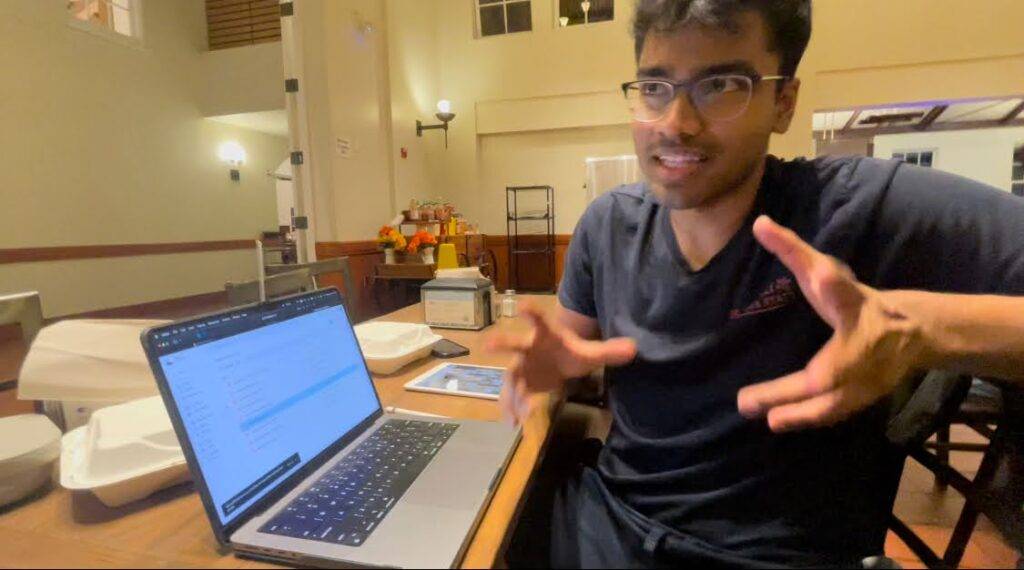
Key Takeaways:
- Found some smaller mistakes in the overall plot: There were a few name discrepancies between Steve/Ben Anderson, wondering why Ariana had the ring before the wedding, which is when it went missing, and more.
- Challenge/Difficulty: He clarified multiple times that there “is there definitely no ambiguity? There is a right answer? From the clues?” After we said yes, he returned to the clues more carefully focusing on dates and times.
- Suspect Sheet: Liked seeing all the character’s visually. “It was certainly helpful!” Appreciated the ambiguity, not knowing who they are from the beginning. He was also the first playtester who went through the rooms based on people’s relation with each other. Instead of following a top-down logic or left to right pattern, this playtester first went through all the Thompson rooms, then the Shah rooms, then the remaining characters’ rooms.
- Space: When looking at the sketches of each room, since the aerial view of the room doesn’t change, it was only possible to look for evidence in places that indicated there was something to look for. For example, it was impossible to know that there was one room where a clue was hidden underneath a rug, because that is not clear from our sketches of the space.
- Evidence: Not sure what evidence cards to commit to and read carefully (the newspaper in Roshan’s room is important to read) vs just skimming its contents (the WikiHow in Melinda’s room). To maintain player’s attention and engagement, can consider being more intentional about which clues are more or less text heavy.
What Went Well:
- He spent a lot of time (over 1 hour) going through all of the evidence, taking notes, and was able to identify Ashley and Evan as the people responsible for the theft of the ring. Missed the final piece of evidence showing the Ashley framed Evan, but this was the first playtest where our playtestor identified the correct suspects based on the evidence.
- Wanted to go back through all the evidence before making the final call
- Suggested imposing a time-limit to increase challenge, but our group decided we wanted to prioritize the exploration of uncovering the embedded narrative over simply finishing the game quicker.
What Didn’t Go Well:
- The text felt tiring to read after a point. “It’s a lot of text to go through in general.”
- Unsure of who Dani is. Felt like he got to understand most of the other characters, but still has no idea what Dani’s narrative is.
- Flipping through evidence and rooms in google drive could be smoother. Hopefully the tech helps solve this.
Our playtester was navigating through room layouts on one laptop, viewing evidence on a second laptop, and taking notes on the iPad
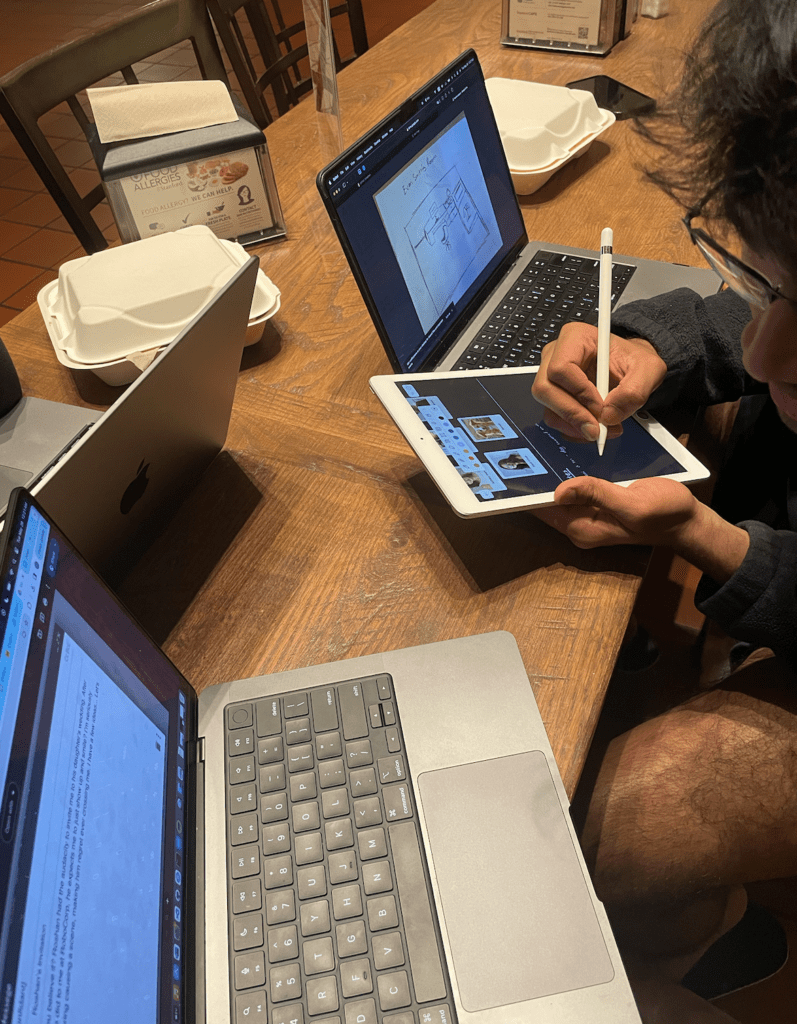
Iterations/Next Steps:
- For this iteration, we spent more time making sure the dates and times of all evidence lined up. Also, making sure there was clear evidence in the diary entries that implies that Ashley could have framed Evan for this crime.
- After this playtest, we went back through some of the really text heavy clues that were less relevant, and added more pictures to replace the text. Examples of this were the WikiHow. However, we also intentionally kept some of the irrelevant evidence text heavy to encourage players to put in the time and effort to solve the mystery. We thought it would make the ending more satisfying.
- Began thinking about the end of the game and what that looks like.
Playtest 7: Digital Game Mechanics
Date: May 28, 2024
Participants: 1 classmate in class
Playtest Questions:
- Do the mechanics of moving around a room and interacting with evidence (i.e. expanding, zooming, and moving) feel natural and intuitive?
- At this point in the design process, we began to transfer our game, which previously existed as a Google Drive folder that players could explore, to a digital game using Unity. In this playtest, we aimed to gather information on how users felt interacting with the basic mechanics of the digital game.
Navigating the game space using digital interactions.
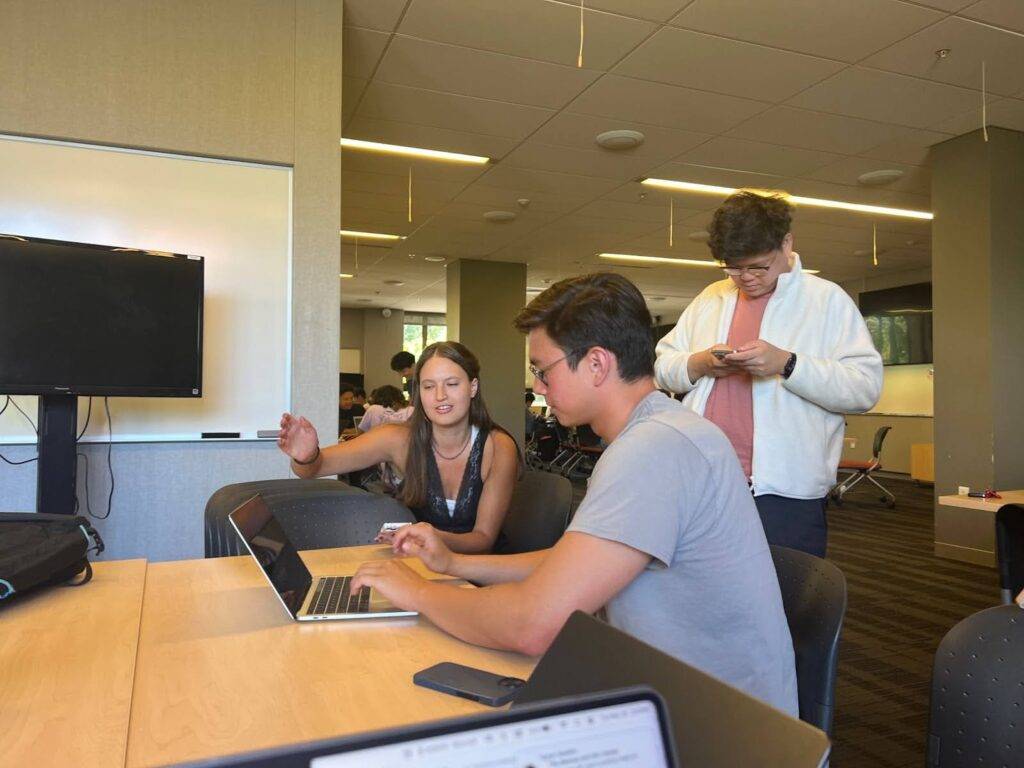
Key Takeaways:
- The mechanics of the digital game were intuitive for players, but more would be useful so that players do not get “stuck” when they forget how to interact with the space.
What Went Well:
- Intuitiveness of Interaction: The playtester felt that the interactions were intuitive, he was very quick able to navigate and interact with the space and evidence using our initial direction.
What Didn’t Go Well:
- Clarity of Interaction: The playtester said he would have liked if there was more direction for the case the user cannot remember how to interact with space. For example, messages indicating how to close the evidence when it is expanded.
Iterations/Next Steps:
- Adding More Direction: As a result of this playtest, we added more help messages to the digital game. Specifically, we added messages that indicate how to close expanded evidence, along with how to interact with expanded evidence (these only display when the play has actually expanded evidence).
- Onboarding: We added an onboarding stage to the game that introduced each mechanic of the game at the same time as introducing the game’s narrative. We started the player off in a room containing only a single piece of expandable evidence. We begin by prompting the player to approach this evidence with a message at the bottom of the screen (and a message indicating how to move the character on screen). They are then prompted to expand the evidence and step through each mechanic one at a time, all using messages at the bottom of the screen. This experience forces the player to try each out each mechanic before moving on to the next. We also chose to introduce the mechanic of the character list later, after the introduction video. This is because, initially, the player did not have the context to understand why they need this character list. It’s only after the video that the player understands their role in the wedding and investigation.
Initial onboarding scene. This is where the player begins the game.

Playest 8: Full Digital Game
Date: June 4, 2024
Participants: 2 classmates in class
Playtest Questions:
- Do users still experience narrative fun while playing the game in digital form? Are any of the digital game interactions limiting in this sense?
- We had mainly tested our narrative structure through a Google Drive folder containing all the rooms and evidence. This was our first playtest using the digital unity app instead. We were interested in how well the game had translated from the folder to being an actual space that the player has to move around in. Are the players still equally engaged in the narrative when the game is in this form? Are any of the user interaction mechanics of the digital game hindering the game-play experience?
Key Takeaways:
- Players could still navigate the narrative of our game in digital form. However, they would have liked a bit more guidance/direction, and some bugs in our implementation made gameplay less smooth than it could have been.
What Went Well:
- Narrative Persisted: The two playtesters were able to uncover narrative in a similar manner to what we had seen in previous playtests using the Google Drive folder. Overall, the mechanics of moving around the space and interacting with evidence did not seem to be limiting their narrative experience. The players investigated evidence and used the in-game character list in a similar manner to how they had in the lower-fidelity version. And, again similar to in previous playtests, the players seemed to experience fun through fellowship with each other, along with through narrative and challenge.
Players interacting with expanded evidence: a text message
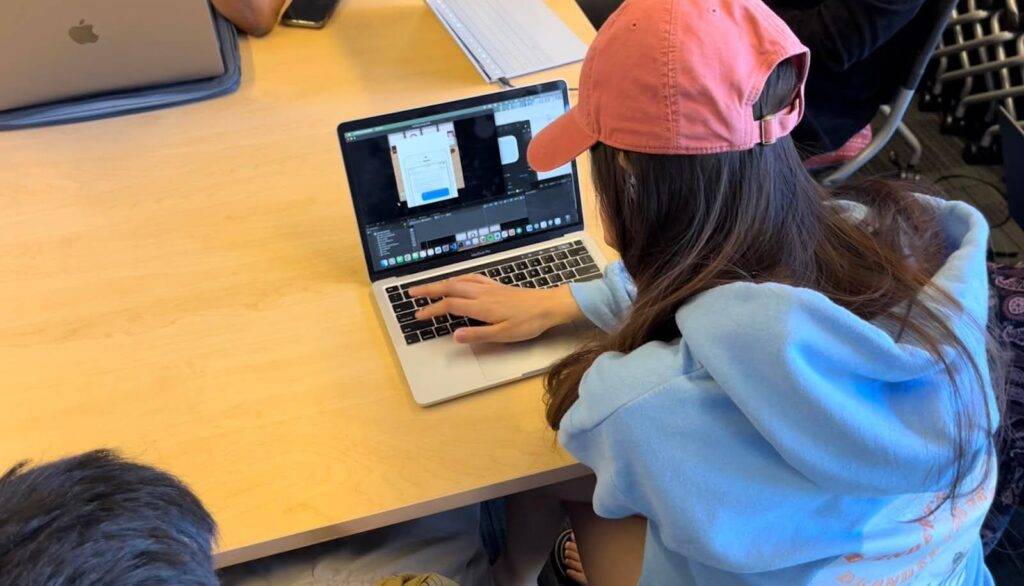
Players referencing and taking notes in the suspect list
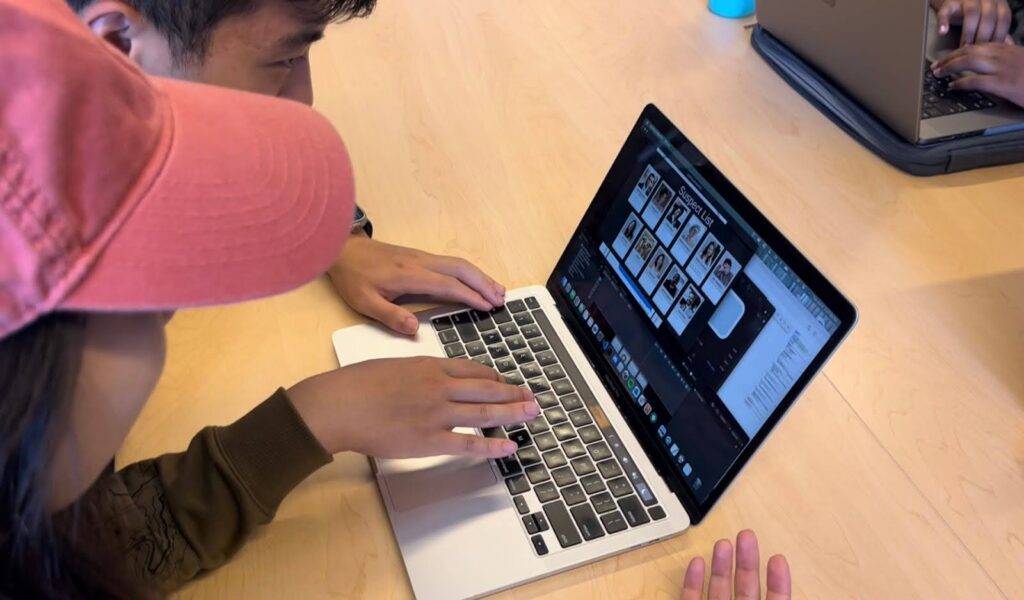
What Didn’t Go Well:
- Buggy Code: At this point in the development process, the mechanics that we had implemented in the digital game contained several bugs. Although the playtesters were still able to navigate the game, we believe that these bugs limited their motivation to engage with the game.
- Attention to Detail: The playtesters wanted to finish the game quickly. This meant that they were not thoroughly engaging with each piece of evidence that they encountered. Because of this lack of attention to detail, the playtesters were not successfully above to solve the mystery of who stole the ring. We talked with Anabelle about this and concluded that this was partially due to the nature of our game and playtesting in class. Part of the fun of our game comes from the challenge of having to notice details about the evidence. Some players are not willing to put in this effort, but these are not the players that we are designing for.
- Information Overload: The playtesters felt that there was way too much evidence and information to keep track of while playing. This was a new development considering in the Google Drive folder version of the game, it was very clear to players whether or not they had seen all the clues or not. They suggested that we implement a log of all clues that the player has seen so far or that we reduce the number of characters to only five or six.
Iterations/Next Steps:
- Fix Bugs: This playtest illuminated many bugs that we were unaware of, such as the player being able to move when the Character List is open, or multiple pieces of evidence expanding at once when they are too close together. We iterated on the digital game by fixing these bugs.
- Overall Evidence Counter: To address information overload and the playtesters’ unclarity over the fraction of total information that they knew about, we decided to implement a counter of the number of clues that the player had encountered out of the total number of clues. This counter is always present in the bottom right corner of the screen. We felt that this struck a good balance between making it easier for the player to understand how much information they knew and the freeform and challenging nature that we are trying to achieve in this game.
- Expanded Counter: As another way of addressing information overload, we also implemented a counter that indicates the number of images that are part of a single expandable item. Similar to the overall counter, this number displays on the bottom of the screen as a fraction. This fraction only displays when the user has expanded an object. Had we had more time, we would have also implemented a hover-over description of both of these statistics.
Playtest 9: Final Playtest
Date: June 4, 2024
Participants: Krishnan and 1 classmate from class
Playtest Questions:
- Do users still experience narrative fun while playing the game in digital form? Are any of the digital game interactions limiting in this sense?
- Is the onboarding tutorial effective in conveying all of the digital mechanics?
- Does the introduction video convey the necessary background information about setting, characters, and the player’s objective?
- When players spend enough time looking at the details of the evidence, are they able to uncover the correct narrative for who stole the ring?
Key Takeaways:
- Player Persona: “Who am I in the game?” Krishnan mentioned that he never really knew what role he played in the game. Neither our introduction nor the tutorial actually provided the player(s) with their role and final objectives.
- End of the Game: Creating a method for players to reveal their final guess on the digital game. Krishnan recommended tying this back to the “player’s persona” where maybe they go to the bride and groom when revealing their final guess.
- Tutorial/Onboarding: The actual onboarding was great, everything made sense. We observed playtesters needed verbal reminders to use the (-/=) buttons to zoom in and out of evidence cards.
What Went Well:
- Playtesters spent a lot of time meticulously going through the evidence and the narratives that our team spent a lot of time crafting!
- They were able to identify Ashley and Evan as the final suspects.
- The onboarding process was nearly perfect. They only needed a reminder about the zoom in/out of evidence feature.
What Didn’t Go Well:
- They were wondering what their role was as players in the game. Who are they, how is it related to the game, why are they uncovering who stole the ring?
- While playing, Krishnan asked, “is there anything else in this room to look at?” There was confusion that partially adds to the challenge but can also detract from the fun.
- There were technical glitches throughout the game, but our note-taker wrote all of them down which we went back to address afterwards.
Iteration/Next Steps:
-
- We made no iterations since playtest 8 since we conducted both playtests back to back, but we did make many changes to our final game based on observations and feedback from these final playtests.
- Tutorial: Krishnan mentioned the coffee evidence image seemed irrelevant in the tutorial. We went ahead to change that to a confidential letter the player is receiving which explains the player’s persona (another piece of feedback we received) as a private investigator who was hired by Elijah Thompson and Ariana Shah. The letter also states that once the player has found the culprit, they should report this back to Elijah and Ariana, implying how the game could end.
- Player Persona: As mentioned, we made the players private investigators who were hired to find the person who stole the ring! The onboarding process was edited to include this information.
-
- Introduction Video: Based on playtester feedback, we edited the video to allow readers more time to read all of the information. Additionally, we removed text from clips where it was more difficult to read the text because of the background video.
- Suspect Sheet: We had lots of feedback on our suspect sheet format, and based on our final playtest with Krishnan, he enjoyed the open-ended note taking feature where you could see the names and faces of each suspect, but not their role. Krishnan did mention that he would appreciate more space for note-taking. We loved that feedback, and definitely want to implement it for a future version of the game, but did not have time this past week to figure out its technical implementation.
- Evidence Technical Mechanics: Playtesters didn’t know when there was more than 1 piece of evidence at a given location. Therefore, we added the pink bar below each piece of evidence which reminds users of key controls and also whether there is more than 1 piece of evidence in that location.
- Progress Tracker: Many playtesters, including Krishnan, expressed that they would appreciate knowing how many clues were hidden in each room. That way, they knew when to move on to the next room, or whether to keep looking if they had missed one. We loved that idea of providing some immediate feedback to players as they were discovering new clues. However, we decided to slightly alter its implementation. We thought it would remove some of the challenge if we kept individual evidence counters for each room. Therefore, we instead implemented an overall progress tracker which tells players how many of the total 88 pieces of evidence they have found and viewed. Then, before they go to submit their final guess, they will know whether they’ve seen every evidence we provided or not.
- Evidence Bank: Some playtesters also mentioned they would appreciate an evidence bank where they can easily view all of the evidence they already found. Our group decided that we actually preferred if players had to revisit rooms to find the evidence instead of having it easily collated for them in an evidence bank.
- Room: Krishnan mentioned that he would appreciate knowing which room he is in without having to exit and re-enter the room. We added the suspect’s name at the top of each room layout now.
- End State: In our final digital game, we included a drop-down for players to indicate who they believe stole the ring: the right answer being Ashley! After players select their final choice, our end video plays which walks players through the relevant evidence that was meant to help them identify the truth. It also provides the alibi’s for all the remaining suspects. If the players correctly guess Ashley, they will receive an end video that starts with a “Congrats” slide. If the players guess incorrectly, they will receive an end video that starts with a “Not Quite…” slide. The end video was created from feedback we received throughout many different playtests, incorporating the reasoning for why all other guesses were incorrect. Playtesters enjoyed knowing why each option did or did not work.
- Music: The music for our introduction and end video were both tracks taken from the Bridgerton Netflix tv series. They were fully instrumental which made it easy to read text, and we felt like they embodied the same theme/vibes as the elegant and expensive wedding where this crime takes place. The tracks were chosen intentionally to help create the setting and atmosphere we were designing.
Both the overall evidence counter and the expanded evidence counter are at the bottom of the screen in the pink bar. 1/4 indicates that the player is currently viewing the first out of three images of the expanded object, and 2/88 indicates that the player has viewed two out of all 88 clues.
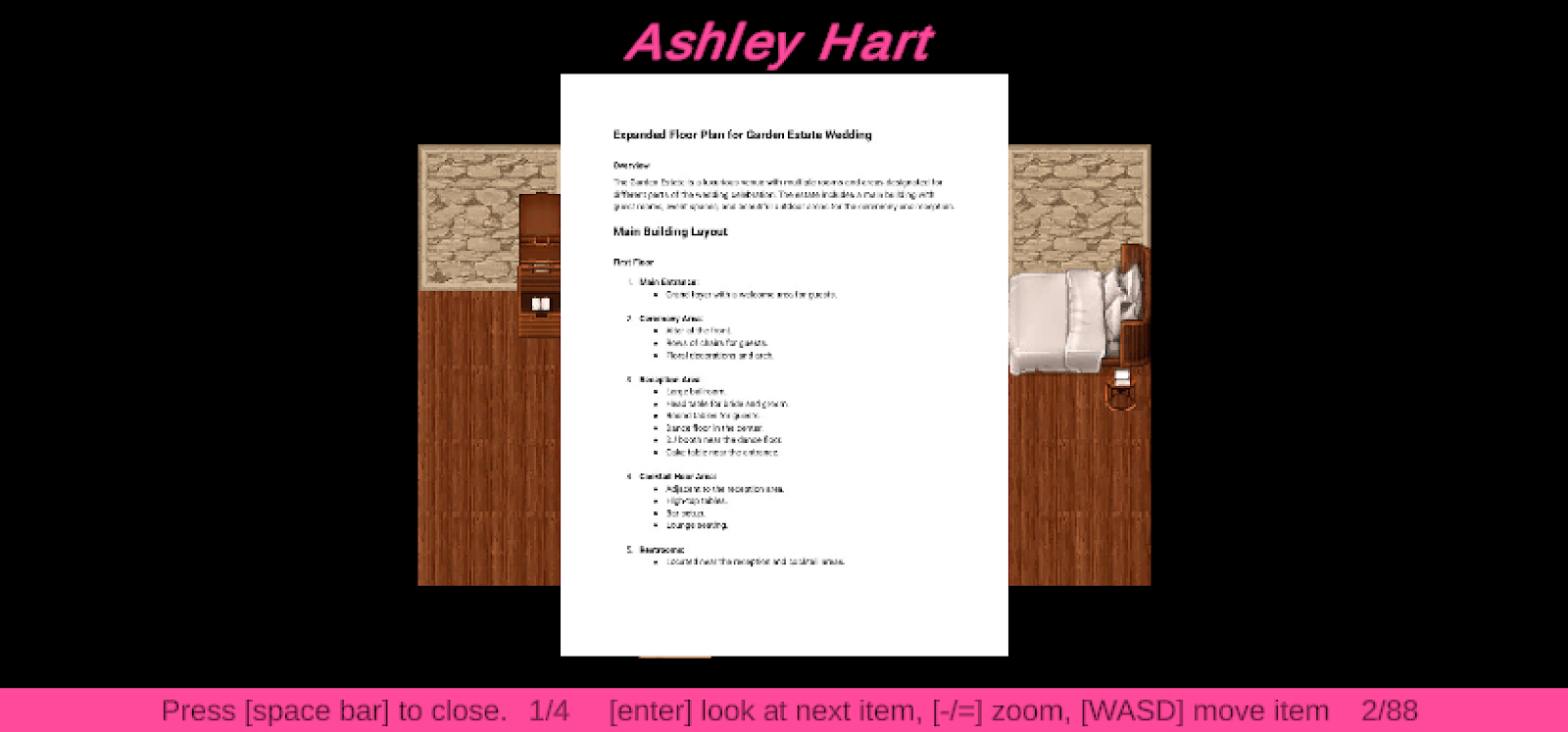
One of the many rooms that the playtesters explored.
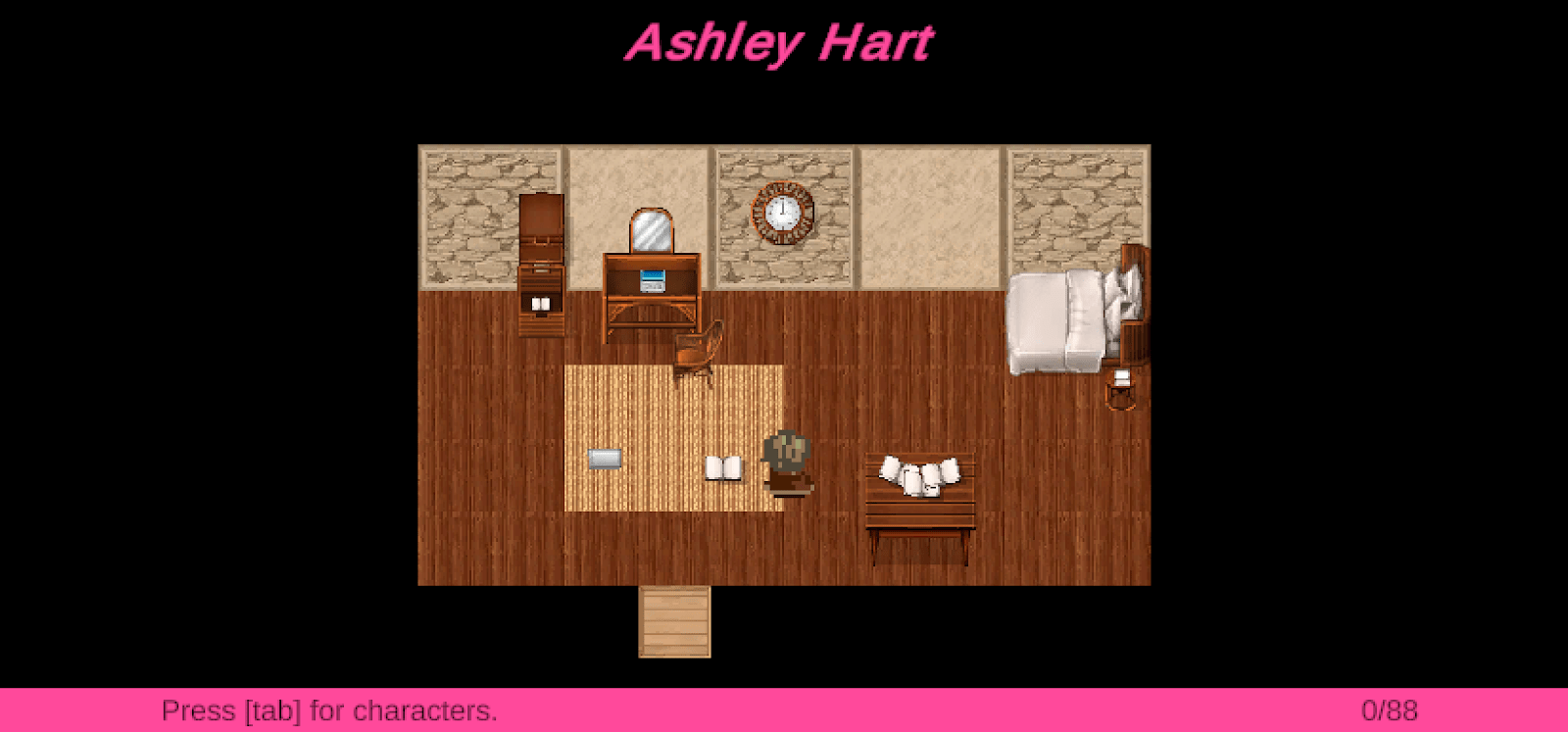
The playtesters were able to eliminate possible suspects by using clues that indicated they had alibis during the time of the crime.
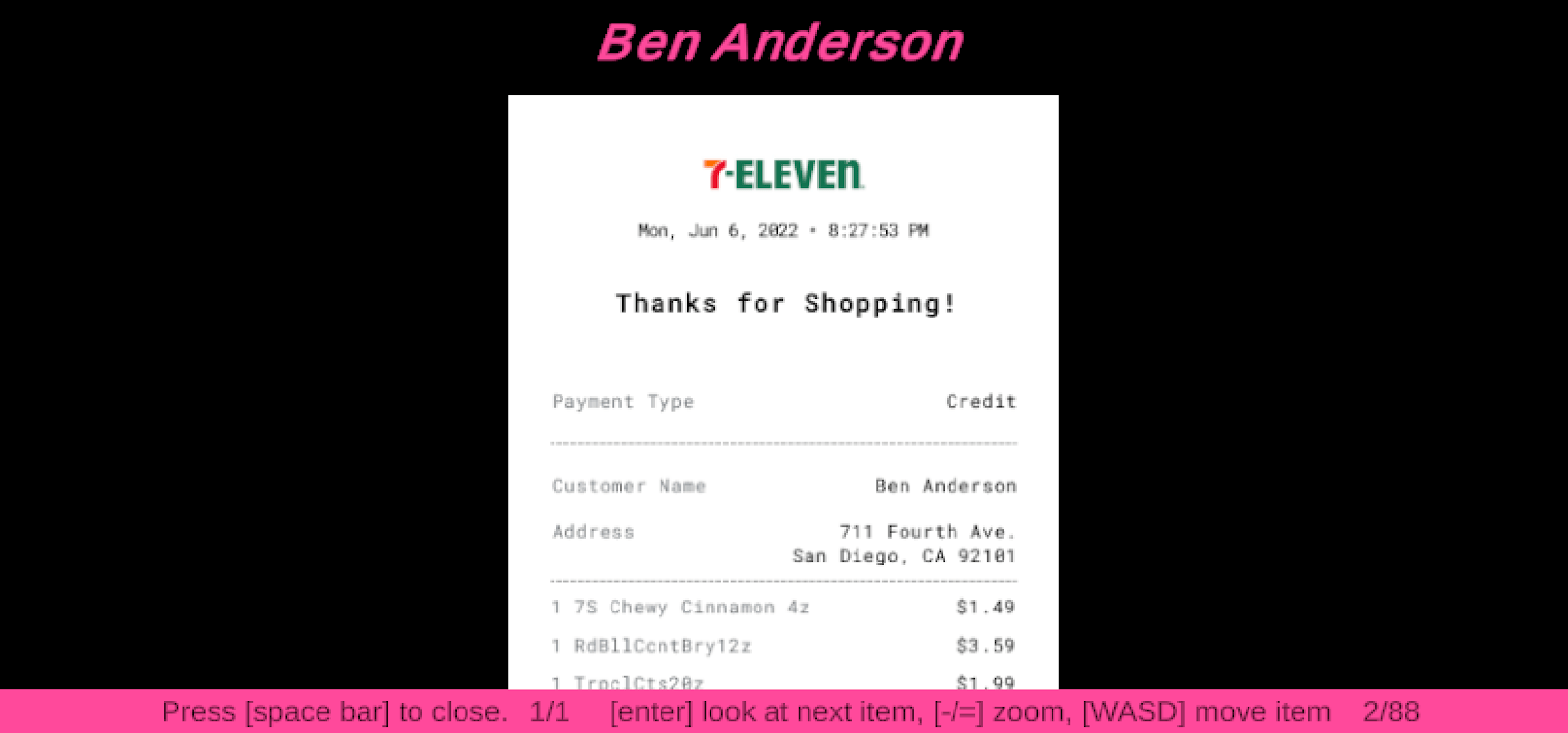
Iterating on feedback from this playtest, we decided to structure the end of the game as a response to the bride and groom.